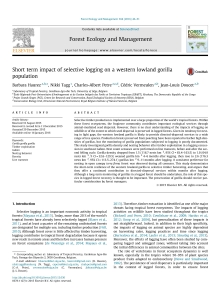Haurez B., Tagg N., Petre C.A., Vermeulen C., Doucet J.L.
Selective timber production is implemented over a large proportion of the world’s tropical forests. Within these forest ecosystems, the frugivore community contributes important ecological services through animal-mediated seed dispersal. However, there is no clear understanding of the impacts of logging on wildlife or of the extent to which seed dispersal is preserved in logged forests. Given its tendency for nesting in light gaps, the western lowland gorilla is likely to provide directed-dispersal services to a wide range of tree species. Production forests preserved from poaching have been reported to harbor high densities of gorillas, but the monitoring of gorilla populations subjected to logging is poorly documented. This study investigated gorilla density and nesting behavior after timber exploitation in a logging concession in southeast Gabon. Nest count censuses were performed on line transects, before and after the second felling cycle. Gorilla density dropped from 1.5 (116.7 nests km-2, 95% CI = 83.4–163.5) to 1.0 (64.9 nests km-2, % CI = 32.6–129.5) weaned gorilla km-2 4–6 months after logging, then rose to 2.6 (176.3 nests km2, 95% CI = 113.5–274.1) gorillas km-2 9–11 months after logging. A consistent preference for nesting in open canopy terra firma forest was observed during all censuses. This study demonstrates the short-term resilience of the western lowland gorilla to selective timber harvesting, and argues that they offer a continued contribution to directed-dispersal services within months after logging. Although a long-term monitoring of gorillas in a logged forest should be undertaken, the role of this species in logged forest recovery is thought to be important. The preservation of gorilla should receive particular consideration by forest managers.
Consultez la notice complète de l’article sur ORBi

